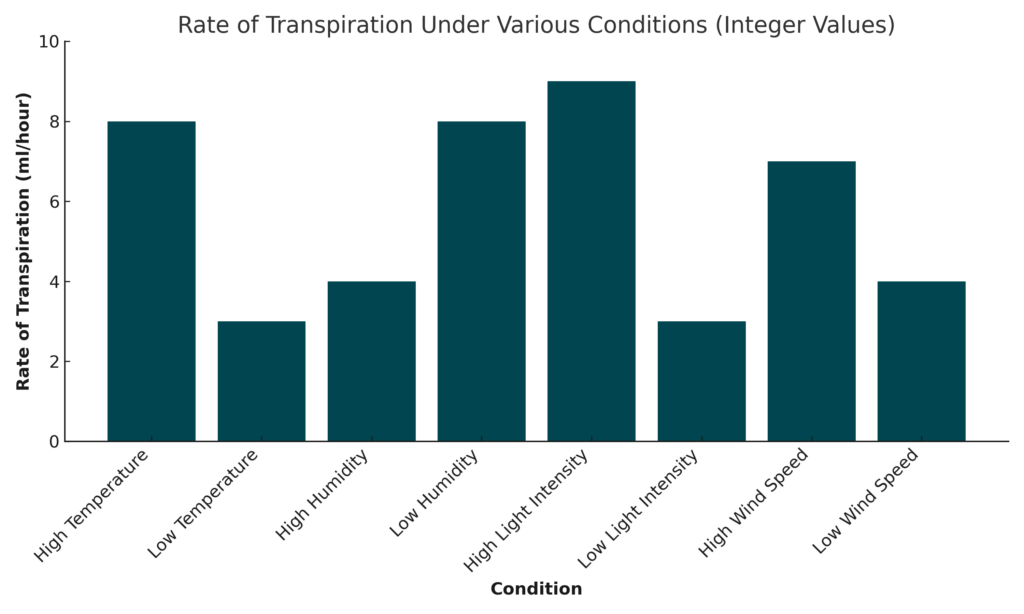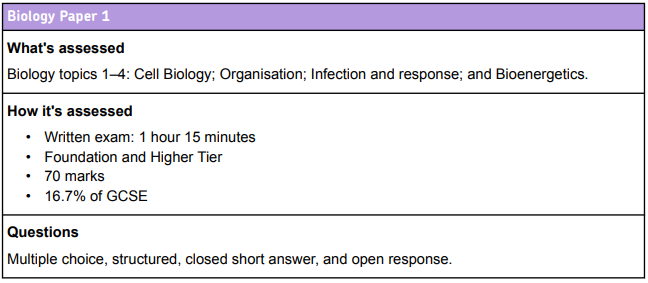Mock test. 70 marks available.
GCSE AQA Combined Science Trilogy Paper 1
Quiz Summary
0 of 28 Questions completed
Questions:
Information
You have already completed the quiz before. Hence you can not start it again.
Quiz is loading…
You must sign in or sign up to start the quiz.
You must first complete the following:
Results
Results
0 of 28 Questions answered correctly
Your time:
Time has elapsed
You have reached 0 of 0 point(s), (0)
Earned Point(s): 0 of 0, (0)
0 Essay(s) Pending (Possible Point(s): 0)
| Average score |
|
| Your score |
|
Categories
- Not categorized 0%
- 6 Mark Questions 0%
- Short Answer 0%
- 1
- 2
- 3
- 4
- 5
- 6
- 7
- 8
- 9
- 10
- 11
- 12
- 13
- 14
- 15
- 16
- 17
- 18
- 19
- 20
- 21
- 22
- 23
- 24
- 25
- 26
- 27
- 28
- Current
- Review
- Answered
- Correct
- Incorrect
-
Question 1 of 28
1. Question
5 point(s)[question number = 01.1] Which sub-cellular structures can be found in animals? (short answer)
Correct 5 / 5 PointsIncorrect / 5 Points -
Question 2 of 28
2. Question
3 point(s)[question number = 01.2] Drag and drop to match the role and structure
Sort elements
- Cytoplasm
- Chloroplasts
- Mitochondria
- Supports and suspends structures within cells and where chemical reactions take place
- Where photosynthesis takes place
- Where aerobic respiration takes place
CorrectIncorrect -
Question 3 of 28
3. Question
3 point(s)[question number = 01.3] Drag and drop to match the role and structure
Sort elements
- Ribosomes
- Cell wall
- Vacuole
- Sites of protein synthesis (where proteins are made)
- Supports the cell providing strength and flexibility for growth
- Stores nutrients and salts
CorrectIncorrect -
Question 4 of 28
4. Question
2 point(s)[question number = 01.4] Palisade cells are found just below the epidermis of leaves. What is their role and how are they adapted to perform it? (short answer)
Correct 2 / 2 PointsIncorrect / 2 Points -
Question 5 of 28
5. Question
5 point(s)[question number = 01.5] The male gametes (sperm cells) are adapted to their function. Describe 5 adaptations of sperm cells. (short answer)
Correct 5 / 5 PointsIncorrect / 5 Points -
Question 6 of 28
6. Question
2 point(s)[question number = 02.1] Use some of the following words to fill in the blanks:
Amidst, with, against, away from
-
In diffusion and osmosis, particles move the concentration gradient, whilst in active transport, particles move the concentration gradient.
Correct 2 / 2 PointsIncorrect / 2 Points -
-
Question 7 of 28
7. Question
3 point(s)[question number = 02.2] (short answer) Which factors affect the rate of diffusion?
Correct 3 / 3 PointsIncorrect / 3 Points -
Question 8 of 28
8. Question
1 point(s)[question number = 02.3] Multicellular organisms are too large to allow diffusion through their cells to provide the necessary resources. Instead we have transport systems. What is the name of the transport system that uses capillaries to transport substances via the blood? (short answer)
CorrectIncorrect -
Question 9 of 28
9. Question
4 point(s)[question number = 02.4] Drag and drop to match the function to the correct part of blood
Sort elements
- Plasma
- White blood cells
- Red blood cells
- Platelets
- Carrying dissolved substances around the body
- Protecting the body from foreign cells
- Carrying oxygen around the body via haemoglobin
- Healing wounds by clotting the blood
CorrectIncorrect -
Question 10 of 28
10. Question
4 point(s)[question number = 02.5] (short answer) Describe the role and structure of veins
Correct 4 / 4 PointsIncorrect / 4 Points -
Question 11 of 28
11. Question
2 point(s)[question number = 02.6] Capillaries are only one cell thick and have thousands of branches. What is the function of capillaries? (short answer)
Correct 2 / 2 PointsIncorrect / 2 Points -
Question 12 of 28
12. Question
1 point(s)[question number = 02.7] If coronary arteries are blocked, new blood vessels can be inserted, what is this procedure called? (short answer)
CorrectIncorrect -
Question 13 of 28
13. Question
2 point(s)[question number = 03.1] Use some of the following words to fill in the blanks:
Companion, guard, root hair, translocation, transpiration
-
Complete the statement: During sucrose is transported in the sieve tubes of phloem vessels. cells pump sucrose across sieve cells up shoots or down to storage organs.
Correct 2 / 2 PointsIncorrect / 2 Points -
-
Question 14 of 28
14. Question
3 point(s)[question number = 03.2] Use some of the following words to fill in the blanks:
Phloem, xylem, guard cells, stream, stomata, root hair cells, hoses
-
Complete the statement: Water is pulled up the vessels as water evaporates from the vessels in the leaves. As the water vapour diffuses through the more water evaporates from the vessels. This creates a continuous chain of water called the transpiration .
Correct 3 / 3 PointsIncorrect / 3 Points -
-
Question 15 of 28
15. Question
5 point(s)[question number = 03.3] Look at the graph below:
Fill in the table below based on the graph.
-

Condition Rate of Transpiration (ml/hour) High Temperature 8 Low Temperature 4 Low Humidity 9 Low Light Intensity 3 High Wind Speed Low Wind Speed 4
CorrectIncorrect -
-
Question 16 of 28
16. Question
1 point(s)[question number = 04.1] What is the balanced chemical equation for photosynthesis?
CorrectIncorrect -
Question 17 of 28
17. Question
5 point(s)[question number = 04.2] (short answer) One of the products of photosynthesis is glucose. Describe the uses of glucose produced during photosynthesis.
Correct 5 / 5 PointsIncorrect / 5 Points -
Question 18 of 28
18. Question
3 point(s)[question number = 04.3] Which of the following are 3 of the adaptations of leaves for efficient photosynthesis?
Correct 3 / 3 PointsIncorrect / 3 Points -
Question 19 of 28
19. Question
6 point(s)[question number = 04.4] The rate of photosynthesis in pondweed can be affected by temperature. Describe a method you could use to investigate the effect of temperature on the rate of photosynthesis. (enter your answer)
You should include:
- how you would set up the apparatus and the materials you would use
- the measurements you would make
- how you would control other variables.
Correct 6 / 6 PointsIncorrect / 6 Points -
Question 20 of 28
20. Question
1 point(s)[question number = 05.1] Use one of the following words to fill in the blank:
Microbe, pathogen, insect, pest-
Complete the sentence. A is a disease-causing organism.
CorrectIncorrect -
-
Question 21 of 28
21. Question
1 point(s)[question number = 05.2] How do antibiotics work?
CorrectIncorrect -
Question 22 of 28
22. Question
1 point(s)[question number = 05.3] Which of the following are physical barriers stopping pathogens from entering the body?
CorrectIncorrect -
Question 23 of 28
23. Question
1 point(s)[question number = 06.1] What is the purpose of respiration? (short answer)
CorrectIncorrect -
Question 24 of 28
24. Question
1 point(s)[question number = 06.2] In what part of the cells does aerobic respiration take place? (short answer)
CorrectIncorrect -
Question 25 of 28
25. Question
1 point(s)[question number = 06.3] Which system is responsible for ensuring the supply of oxygen and glucose to cells?
CorrectIncorrect -
Question 26 of 28
26. Question
2 point(s)[question number = 06.4] During exercise, your cells require more oxygen and glucose. What changes in the body happen during exercise to meet these increased needs? (short answer)
Correct 2 / 2 PointsIncorrect / 2 Points -
Question 27 of 28
27. Question
1 point(s)[question number = 06.5] What is the difference between aerobic and anaerobic respiration? (short answer)
CorrectIncorrect -
Question 28 of 28
28. Question
1 point(s)[question number = 06.6] Glucose enters the body via the?
CorrectIncorrect
Is this higher or foundation?
This is a combined paper for higher and foundation students. You can achieve grades 1 – 9 on this paper, so it is suitable for all. Grades are moderated against the average result to give the most accurate indication of your performance. You can look at – How is this paper marked? for more information.
How is this paper marked?
This paper is automatically marked to determine which questions were answered correctly.
Your grade is determined using a Z-Score moderation system. Your GCSE exams are also moderated comparably so that the difficulty of papers is taken into account.
Roughly, this works by calculating your overall percentage and comparing it to the average percentage and the standard deviation. This means that for harder papers you need fewer points to get the same grade as you would for an easier paper.
As more students attempt the paper, the average score and standard deviation more accurately represent the difficulty of the paper and the grades become more accurate.
Making these papers and the marking system took considerable effort so if you found them helpful for your revision, please show your appreciation by rating the page.
Related Quizzes
Which exam board are you studying?


